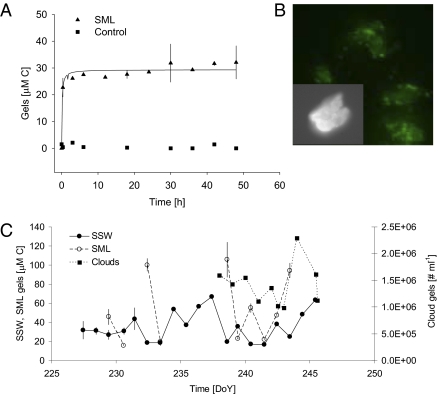Fig. 1.
Polymer gel assembly as a function of time in high Arctic surface waters. (A) We monitored the assembly of polymer gels by measuring the percentage of polymers assembled as microgels at 4 °C (triangles). Control experiments in which Ca2+ was chelated from seawater with 10 mM EDTA showed no assembled gels, regardless of the time of observation (squares). Each point corresponds to the average of three replicates. We note that the assembly occurred very quickly, with the concentration and size of assembled polymer gels reaching equilibrium in 6 h. An average yield of assembly equal to 32% of the polymers in the DOM pool was measured for either SSW or SML water samples. (B) Microgels. Gels stained with chlortetracycline indicate the presence of bound Ca2+; insert at higher magnification. (C) Temporal variability in microgel concentration. During the drift phase of ASCOS at 87°N, we measured microgels in the SSW and SML in units of carbon, whereas we counted microgels in clouds with flow cytometry (as discrete particles) due to the large sample volume required to accurately measure carbon concentration in the microgels. SML microgels were enriched up to a factor of 5 with respect to SSW concentrations.

